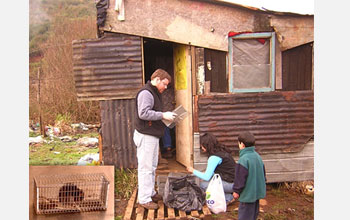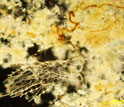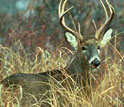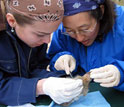News Release 09-191
Ecology of Infectious Disease Grants Awarded by NSF, NIH
Researchers will study links among spread of infectious diseases, global warming and other environmental changes

Trapping and testing rodents is important to understanding transmission of leptospirosis.
October 7, 2009
This material is available primarily for archival purposes. Telephone numbers or other contact information may be out of date; please see current contact information at media contacts.
The spread of malaria to formerly disease-free regions like East Africa's highlands. H1N1, the "swine flu," and the specter of its appearance around the globe. Lyme disease in the eastern U.S. and its transmission in a global warming world.
To better understand the ecological mechanisms that govern relationships between human-induced environmental changes and the emergence and transmission of infectious diseases, the National Science Foundation (NSF) and National Institutes of Health (NIH) have awarded 10 grants through the Ecology of Infectious Diseases (EID) program. It is the tenth year of funding in the joint NSF-NIH program.
Interdisciplinary projects funded through the EID program will study how large-scale environmental events--such as habitat destruction and global warming--alter the risks of viral, parasitic and bacterial diseases in humans and animals.
"Unprecedented rates of change in biodiversity have coincided with the emergence and re-emergence of numerous infectious diseases around the world," says Sam Scheiner, EID program director at NSF, which funds the program through its directorate for biological sciences and directorate for geosciences. "We have to get a handle on why--and how."
The benefits of EID research include: development of disease transmission theory; improved understanding of unintended health effects of development projects; increased capacity to forecast outbreaks; and insights into how infectious diseases emerge and re-emerge.
"The need is being driven by the increased pace of climate change coupled with society's greater global mobility," says Josh Rosenthal, program director at NIH's Fogarty International Center, which co-funded the research.
Human infection with Leptospira, for example, can occur after contact with infected animals or with a contaminated environment, says Claudia Munoz-Zanzi of the University of Minnesota, an EID grantee. It's usually associated with agricultural practices, contamination of household or recreational water, poor housing and waste disposal, or changes in the density or proximity of infected animals such as rodents, domestic animals and wildlife. Munoz-Zanzi will study the ecological and sociological elements that influence human infection in rural, peri-urban and urban communities in Latin America to identify intervention strategies for reducing the disease's impact on human health.
Fred Dobbs, Maille Lyons and colleagues at Old Dominion University and other institutions will look at "marine snow" (organic detritus in oceans and estuaries) to investigate its role in the persistence of aquatic pathogens, or disease-causing organisms. The concepts of island biogeography may apply to bacterial pathogens in aquatic environments, the scientists believe, especially to those disease-causing organisms that flow from point sources of pollution and are subsequently incorporated into aggregates of marine snow. These "microscopic islands" may carry pathogens as they're transported in currents. Among the team's goals is improving decisions made by water-quality managers about opening or closing beaches and shellfish beds.
Chronic wasting disease, or CWD, affects members of the deer family. CWD is similar to diseases like mad cow disease--or bovine spongiform encephalopathy--in cattle. It's caused by misfolded proteins that resist breakdown by enzymes within cells. These proteins cause fatal neurological damage. Understanding and managing CWD depends on developing predictive models that track how the disease spreads. Biologist Tom Hobbs of Colorado State University will model the impact of CWD on deer populations in an effort to better understand the dynamics of the disease's transmission. CWD is an important challenge for managing wildlife resources in Colorado, says Hobbs.
This year's awards will address:
- Ecological dynamics of bacterial pathogens: transmission of virulence factors (Jim Bever, Indiana University)
- Spatial modeling of onchocerciasis foci in Africa by remote sensing (Thomas Unnasch, University of South Florida)
- Linking host behavior to disease transmission in the ranavirus-salamander system (Jessie Brunner, SUNY College of Environmental Science and Forestry)
- Island biogeography and aquatic pathogens colonizing marine aggregates (Fred Dobbs, Old Dominion University)
- Bayesian hierarchical modeling of disease dynamics: a case example using chronic wasting disease (Tom Hobbs, Colorado State University)
- Transmission of infections by intermittently shed pathogens with environmental persistence (Renata Ivanek Miojevic, Texas Agricultural Experiment Station)
- Eco-epidemiology of leptospirosis in Latin America (Claudia Munoz-Zanzi, University of Minnesota)
- The role of environment and direct transmission in chronic wasting disease dynamics (Michael Samuel, University of Wisconsin-Madison)
- Quantifying the influence of environmental temperatures on transmission of vector-borne diseases (Matthew Thomas, Penn State University)
- Gradients in Lyme disease in the eastern U.S. (Jean Tsao, Michigan State University)
-NSF-
-
Harmless it's not: marine snow in estuaries and oceans often carries pathogens.
Credit and Larger Version -
Chronic wasting disease (CWD) affects deer and elk and is related to mad cow disease.
Credit and Larger Version -
Blacklegged ticks--key carriers of Lyme disease--are tiny menaces.
Credit and Larger Version -
Michigan State researchers Sarah Hamer and Chris Neibuhr look for ticks on a wild rabbit.
Credit and Larger Version
Media Contacts
Cheryl Dybas, NSF, (703) 292-7734, email: cdybas@nsf.gov
Ann Puderbaugh, NIH, (301) 402-8614, email: puderba@mail.nih.gov
Related Websites
NSF Ecology of Infectious Diseases Program: http://www.nsf.gov/funding/pgm_summ.jsp?pims_id=5269
NIH Ecology of Infectious Diseases Initiative: http://www.fic.nih.gov/programs/research_grants/ecology/
Ecology of Infectious Diseases: An NSF Special Report: http://www.nsf.gov/news/special_reports/ecoinf/index.jsp
The U.S. National Science Foundation propels the nation forward by advancing fundamental research in all fields of science and engineering. NSF supports research and people by providing facilities, instruments and funding to support their ingenuity and sustain the U.S. as a global leader in research and innovation. With a fiscal year 2023 budget of $9.5 billion, NSF funds reach all 50 states through grants to nearly 2,000 colleges, universities and institutions. Each year, NSF receives more than 40,000 competitive proposals and makes about 11,000 new awards. Those awards include support for cooperative research with industry, Arctic and Antarctic research and operations, and U.S. participation in international scientific efforts.
Connect with us online
NSF website: nsf.gov
NSF News: nsf.gov/news
For News Media: nsf.gov/news/newsroom
Statistics: nsf.gov/statistics/
Awards database: nsf.gov/awardsearch/
Follow us on social
Twitter: twitter.com/NSF
Facebook: facebook.com/US.NSF
Instagram: instagram.com/nsfgov




